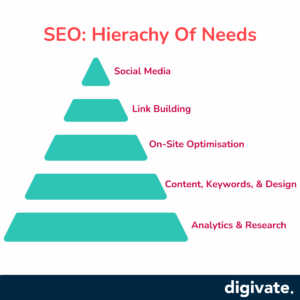
Search Engine Optimisation (SEO) is revealed below as a hierarchy of needs – a pyramid of interdependent and complimentary fundamental requirements.
Like Maslow’s (1954) hierarchy of psychological needs, it is helpful to view the SEO campaign fundamentals as a pyramid.
Just like Maslow’s hierarchy of human needs, SEO has its own set of essential building blocks. These components are interdependent and need to be fulfilled in order to achieve a well-optimised site. Viewing SEO in this way helps marketers understand the critical steps needed for a campaign’s success.
Referring to SEO’s hierarchy of needs can be of enormous practical use. It can form the basis of planning – each level constituting a project milestone. And in the implementation phase, the structure can serve as a simple but powerful checklist – ensuring that the key strategic priorities of the campaign are delivered by the plan.

Foundation: Analytics and Research
The most fundamental elements of all – analytics and research – are represented as the foundation or base of the pyramid. These elements are vital. They must be addressed first and should be revisited continually throughout a properly organised search campaign.
In the foundation stage, tools like Google Analytics and Semrush can provide critical data on audience behaviour and keyword opportunities. For instance, by analysing time on page and engagement rates, you can identify underperforming pages that need optimisation.
Skipping the foundational step of research can lead to wasted effort later. If your keywords and audience aren’t well understood from the outset, all your on-page optimisations and link-building efforts could be misdirected, failing to drive the traffic you’re aiming for.
Building Blocks: Content, Keywords, Architecture, and Design
Once the research is done, the content creation process begins. Imagine you’re building out product pages for an e-commerce site. Based on your research, you identify ‘sustainable running shoes’ as a high-potential keyword. You can then develop a series of blog posts, product descriptions, and category pages centred around that keyword, optimised with long-tail variations. Meanwhile, your site architecture ensures these pages are easy to navigate, while your design supports a user-friendly experience.”
The composition of these will be carefully based on intelligence gained from analytics and research – ensuring that campaigns are properly targeted to achieve results and deliver ROI (return on investment).
If you skip this step or execute it poorly, you risk creating irrelevant content that doesn’t resonate with your audience or rank well. Content and site architecture must be built on the insights gained from research to ensure they are structured for user engagement and search engine visibility. Proper keyword targeting and optimised site design improve user experience and encourage better search engine crawling, directly impacting your site’s performance and search rankings.
On-Site Optimisation
Then the site is ‘optimised’ for users and search engines. Page elements are checked, ensuring they are in line with the original analytics and research undertaken at the outset.
Optimising on-page elements like title tags, meta descriptions, and alt text can dramatically improve your site’s visibility in search results. For instance, optimising a blog post by adding relevant keywords into the title tag (‘Best Running Shoes for 2024 | Sustainable and Eco-Friendly Options’) can make it more likely to rank for those keywords. Moreover, improving page speed by compressing images and using caching can enhance user experience and reduce bounce rates.
Without proper on-site optimisation, even the best content might not rank well. Search engines need clear signals about your content’s topic and relevance. Skipping optimisation can also lead to a poor user experience—slow loading times, broken links, or poorly structured headers make users leave your site, harming both rankings and conversions. On-site optimisation ensures that both search engines and users can easily navigate and understand your content.
The Power of Link Building
Finally, links are built – representing in many ways the culmination (and theoretically the most powerful) element of the SEO campaign. It is important to remember that on-site optimisation and link-building are only effective if they are built upon intelligence gained through analytics and research – the foundation of the campaign.
You should focus on acquiring high-quality backlinks from relevant websites. For example, if you’re running a travel blog, you could guest post on a popular travel site and link back to your own content. Another tactic could be creating shareable infographics or data-driven studies that encourage other sites to link to your work.
Link building is critical because backlinks from authoritative sites signal trust to search engines. However, without the foundational research and on-site optimisation, links alone won’t drive results. It’s important to remember that backlinks must be relevant and come from credible sources, as poor-quality links can harm your SEO efforts. Building these links helps strengthen your site’s authority, increasing your chances of ranking for competitive keywords.
The Social Media Layer
Social media signals are increasingly important in Search Engine Optimisation. Thus the final, crowning component, perfecting the campaign, is the implementation of social media campaigns. These should be designed to yield maximum engagement and implemented so as to generate the types of signals search engines increasingly use to help determine the topic and importance of every page on a website.
Engaging your audience on social media not only drives direct traffic but also signals to search engines that your content is relevant and valuable. Shares, comments, and backlinks generated through social media platforms contribute to improving your SEO performance.
Climbing the SEO Pyramid – One Step at a Time
SEO is much like scaling a mountain – each stage builds on the one below it, and reaching the top requires a strategic, well-planned approach. By following the hierarchy of SEO needs, you ensure that your foundation is strong, your content is relevant, and your optimisations are effective. Remember, SEO is not a one-time effort but an ongoing process. Revisit each stage regularly to keep your strategy fresh, targeted, and aligned with your goals.
Like the marketing process as a whole, SEO is cyclical and continuous in nature. Effective campaigns do not end – they evolve. Every layer in the SEO pyramid needs to be continually addressed and revisited, often simultaneously, alongside all the others.
But more importantly, SEO must be properly integrated into a broader marketing strategy – ensuring that every channel, every plan and every tactic supports and compliments all the others – contributing effectively and strategically to the campaign and the brand as a whole.
For a London SEO Agency delivering properly integrated, strategic search campaigns, look no further.



